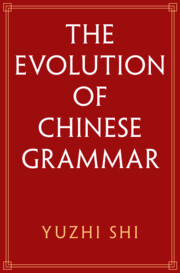Book contents
- The Evolution of Chinese Grammar
- The Evolution of Chinese Grammar
- Copyright page
- Dedication
- Epigraph
- Contents
- Figures
- Tables
- Acknowledgments
- Conventions Used in the Examples
- Abbreviations and Symbols
- 1 Some Preliminaries
- 2 Copular Word and Construction
- 3 Focus and Wh- Words
- 4 Serial Verb Construction
- 5 Disyllabification
- 6 Resultative Construction
- 7 Information Structure
- 8 The Passive Construction
- 9 The Disposal Construction
- 10 Verb Copying and Reduplication
- 11 The Comparative Construction
- 12 The Ditransitive Construction
- 13 Aspect and Tense
- 14 Negation
- 15 The Boundedness of the Predicate
- 16 Classifiers
- 17 Demonstratives from Classifiers
- 18 Distal Demonstratives from Phonological Derivation
- 19 Pronouns, Plurals, and Diminutives
- 20 Structural Particles
- 21 Word Order and Relative Clauses
- 22 Conclusions
- References
- Primary Sources of Texts
- Index
7 - Information Structure
Published online by Cambridge University Press: 16 March 2023
- The Evolution of Chinese Grammar
- The Evolution of Chinese Grammar
- Copyright page
- Dedication
- Epigraph
- Contents
- Figures
- Tables
- Acknowledgments
- Conventions Used in the Examples
- Abbreviations and Symbols
- 1 Some Preliminaries
- 2 Copular Word and Construction
- 3 Focus and Wh- Words
- 4 Serial Verb Construction
- 5 Disyllabification
- 6 Resultative Construction
- 7 Information Structure
- 8 The Passive Construction
- 9 The Disposal Construction
- 10 Verb Copying and Reduplication
- 11 The Comparative Construction
- 12 The Ditransitive Construction
- 13 Aspect and Tense
- 14 Negation
- 15 The Boundedness of the Predicate
- 16 Classifiers
- 17 Demonstratives from Classifiers
- 18 Distal Demonstratives from Phonological Derivation
- 19 Pronouns, Plurals, and Diminutives
- 20 Structural Particles
- 21 Word Order and Relative Clauses
- 22 Conclusions
- References
- Primary Sources of Texts
- Index
Summary
This chapter shows that there were fundamental changes in two types of information structure: one is at the clause level, involving the arrangement of new and given information, and the other is at the predicate level, involving the arrangement of resultative and non-resultative (accompanying) information. The first is cross-linguistically true and can be found in many other languages; the second may be particular to the language and has thus far been known to exist only in Chinese. Throughout the entire history of Chinese grammar, these two principles of information organization are critical for understanding how the grammar has evolved over time. On the one hand, both reflect the results of grammatical developments; on the other hand, they motivated a series of significant changes in history that together have largely shaped the grammatical system of Contemporary Chinese.
- Type
- Chapter
- Information
- The Evolution of Chinese Grammar , pp. 142 - 174Publisher: Cambridge University PressPrint publication year: 2023

